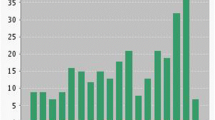Abstract
In an insightful and important article, Lee et al. (2013, this issue) clearly point out the problems with so-called formative measurement. In particular, they suggest that the MIMIC model formulation, as currently conceptualized, does not provide a solution. Their central thesis is that, in a MIMIC model, the supposedly formatively measured latent variable is empirically a reflective latent variable depending entirely on the endogenous variables included. They then look at composite variables as a possible solution. This commentary seeks to reinforce their central thesis, providing additional evidence and support. I also attempt to clarify the distinction between two types of models discussed in the article as MIMIC models. I then examine the use of composite variables, focusing on potential information loss and issues concerning conceptual clarity. I conclude that composite variables should not be routinely employed in theory testing research, and their use must be clearly justified.

Similar content being viewed by others
References
Adams, P., Hurd, M., Mcfadden, D., Merrill, A., & Ribeiro, T. (2003). Healthy, wealthy, and wise? Tests for direct causal paths between health and socioeconomic status. Journal of Econometrics, 112(1), 3–56.
Bagozzi, R. P. (2007). On the meaning of formative measurement and how it differs from reflective measurement: Comment on Howell, Breivik, and Wilcox (2007). Psychological Methods, 12(2), 229–237.
Bagozzi, R. P. (2011). Measurement and meaning in information systems and organizational research: methodological and philosophical foundations. MIS Quarterly, 35(2), 261–292.
Bollen, K. A. (2007). Interpretational confounding is due to misspecification, not to type of indicator: comment on Howell, Breivik, and Wilcox (2007). Psychological Methods, 12(2), 219–228.
Bollen, K. A. (2011). Evaluating effect, composite, and causal indicators in structural equation models. MIS Quarterly, 35(2), 359–372.
Bollen, K. A., & Bauldry, S. (2011). Three Cs in measurement models: causal indicators, composite indicators, and covariates. Psychological Methods, 16(3), 265–284.
Bollen, K. A., & Lennox, R. (1991). Conventional wisdom on measurement: a structural equation perspective. Psychological Bulletin, 110(2), 305–314.
Borsboom, D. (2008). Psychometric perspectives on diagnostic systems. Journal of Clinical Psychology, 64, 1089–1108.
Burt, R. S. (1976). Interpretational confounding of unobserved variables in structural equation models. Sociological Methods and Research, 5(1), 3–52.
Cadogan, J. W., & Lee, N. J. (2013). Improper use of endogenous formative variables. Journal of Business Research, 66(2), 233–241.
Cohen, P., Cohen, J., Teresi, J., Marchi, M., & Velez, C. (1990). Problems in the measurement of latent variables in structural equations causal models. Applied Psychological Measurement, 14(2), 183–196.
Diamantopoulos, A. (2011). Incorporating formative measures into covariance-based structural equation models. MIS Quarterly, 35(2), 335–358.
Edwards, J. R. (2001). Multidimensional constructs in organizational behavior research: an integrative analytical framework. Organizational Research Methods, 4(2), 144–192.
Edwards, J. R. (2011). The fallacy of formative measurement. Organizational Research Methods, 14(2), 370–388.
Franke, G. R., Preacher, K., & Rigdon, E. (2008). Proportional structural effects of formative indicators. Journal of Business Research, 61(12), 1229–1237.
Hardin, A., & Marcoulides, G. (2011). A commentary on the use of formative measurement. Educational and Psychological Measurement, 71(5), 753–764.
Hardin, A., Chang, J., Fuller, M., & Torkzadeh, G. (2011). Formative measurement and academic research: in search of measurement theory. Educational and Psychological Measurement, 71(2), 281–305.
Howell, R. D. (1987). Covariance structure modeling and measurement issues: a note on interrelations among a channel entity’s power sources. Journal of Marketing Research, 14(1), 119–126.
Howell, R. D., Breivik, E., & Wilcox, J. (2007a). Reconsidering formative measurement. Psychological Methods, 12(2), 205–218.
Howell, R. D., Breivik, E., & Wilcox, J. (2007b). Is formative measurement really measurement? Reply to Bollen (2007) and Bagozzi (2007). Psychological Methods, 12(2), 238–245.
Howell, R. D., Breivik, E. & Wilcox, J. (forthcoming). Formative measurement. A critical perspective. The DATA BASE for Advances in Information Systems.
Jarvis, C., MacKenzie, S., & Podsakoff, P. (2003). A critical review of construct indicators and measurement model misspecification in marketing and consumer research. Journal of Consumer Research, 30(2), 199–218.
Lee, N., & Cadogan, J. W. (2013). Problems with formative and higher-order reflective variables. Journal of Business Research, 66(2), 242–247.
Lee, N., Cadogan, J., & Chamberlain, L. (2013). The MIMIC model and formative variables: problems and solutions. AMS Review, this issue.
MacCallum, R. C., & Browne, M. (1993). The use of causal indicators in covariance structure models: some practical issues. Psychological Bulletin, 114(3), 533–541.
Mackenzie, S. B., Podsakoff, P., & Podsakoff, N. (2011). Construct measurement and validation procedures in MIS and behavioral research: integrating new and existing techniques. MIS Quarterly, 35(2), 293–334.
McGrath, R. E. (2005). Conceptual complexity and construct validity. Journal of Personality Assessment, 85(2), 112–124.
Paunonen, S. V., Rothstein, M., & Jackson, D. (1999). Narrow reasoning about the use of broad personality measures for personnel selection. Journal of Organizational Behavior, 20(3), 389–405.
Petter, S., Straub, D., & Rai, A. (2007). Specifying formative constructs in information systems research. MIS Quarterly, 31(4), 623–656.
Treiblmaier, Bentler, P. M., & Mair, P. (2011). Formative constructs implemented via common factors. Structural Equation Modeling-A Multidisciplinary Journal, 18(1), 1–17.
Wilcox, J. B., Howell, R. D., & Breivik, E. (2008). Questions about formative measurement. Journal of Business Research, 61(12), 1219–1228.
Author information
Authors and Affiliations
Corresponding author
Rights and permissions
About this article
Cite this article
Howell, R.D. Conceptual clarity in measurement—Constructs, composites, and causes: a commentary on Lee, Cadogan and Chamberlain. AMS Rev 3, 18–23 (2013). https://doi.org/10.1007/s13162-013-0036-y
Received:
Accepted:
Published:
Issue Date:
DOI: https://doi.org/10.1007/s13162-013-0036-y




